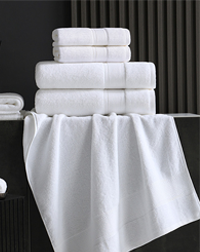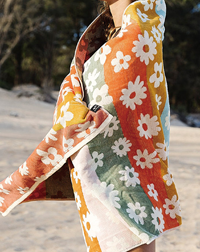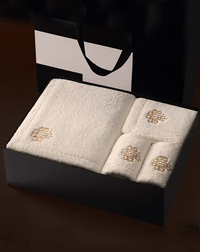Every custom towel you use at home, whether for drying off after a shower or lounging by the pool, has gone through a fascinating journey before it reaches your hands. From selecting raw materials to intricate production processes, each step contributes to creating a high-quality, custom towel that’s as practical as it is personal. In this blog, we’ll take you on a behind-the-scenes tour of how a custom towel is made—from the factory floor to your home.
Step 1: Selecting High-Quality Materials
The journey of a custom towel begins with the choice of materials. The fabric is the foundation of any towel, and selecting the right material is crucial for determining its softness, durability, and absorbency. Common towel materials include:
- Cotton: Egyptian and Turkish cotton are known for their softness and durability. These long-staple cottons create towels that are plush, absorbent, and long-lasting.
- Bamboo: Bamboo towels are an eco-friendly option, offering natural antibacterial properties and excellent absorbency.
- Microfiber: Microfiber towels are lightweight and quick-drying, making them ideal for gym or travel use.
For custom towels, the choice of fabric also depends on the purpose and desired feel. Luxury towels for hotels or spas may prioritize softness, while promotional towels for events might focus on durability and visual appeal.
Step 2: Designing the Custom Towel
Once the material is selected, the design process begins. This is where creativity and branding come into play. Whether the towel is meant for personal use, business branding, or a promotional event, every detail of the design is tailored to fit the client’s vision.
- Logo and Branding: Businesses often opt to have their logos embroidered or printed on custom towels. This creates a lasting impression, whether the towels are used in a hotel, gym, or as promotional giveaways.
- Colors and Patterns: Custom towels can be dyed in a wide range of colors and feature unique patterns or designs that match the brand’s identity or customer preferences.
- Personalization: For personal use, names, monograms, or special messages can be added to make the towel truly one-of-a-kind.
In some cases, clients collaborate with designers to create a mockup of the towel before production begins. This allows for adjustments in layout, logo placement, and color selection to ensure the final product meets expectations.
Step 3: Weaving and Cutting the Fabric
After the design is finalized, the production process begins. The first step is weaving the fabric. In this phase, cotton or other fibers are woven into loops, which gives towels their characteristic softness and absorbency.
- Terry Weave: Most towels use a terry weave, where loops of fiber are woven into both sides of the towel to increase absorbency. The length of these loops can affect the towel’s softness—longer loops create a more plush feel.
- Jacquard Weaving: For custom designs that feature intricate patterns or logos, jacquard weaving techniques may be used. This method allows for complex designs to be woven directly into the towel.
Once the fabric is woven, it is cut to the desired size. Towels come in a variety of sizes, from small hand towels to large bath sheets, depending on the intended use.
Step 4: Dyeing and Printing
The next step in the journey is adding color and design elements. Towels can be dyed in a variety of shades, from classic white to vibrant colors that reflect a brand’s identity or personal taste.
For custom designs, logos, or patterns, printing techniques like screen printing or digital printing may be used:
- Screen Printing: This method applies ink directly to the towel using a mesh stencil. It’s ideal for simple designs and logos.
- Digital Printing: More complex designs with multiple colors or gradients are often created using digital printing, which allows for greater detail and precision.
For luxury or personalized towels, embroidery is a popular option. Logos, names, or monograms are stitched onto the fabric, creating a lasting and elegant finish.
Step 5: Finishing Touches and Quality Control
Before the custom towel leaves the factory, it goes through a series of finishing steps to ensure it meets quality standards. This includes:
- Edge Stitching: The edges of the towel are hemmed to prevent fraying and add durability. High-quality towels often have double-stitched or reinforced hems for longevity.
- Pre-Washing: Towels may be pre-washed to soften the fabric and prevent shrinkage once the customer begins using them.
- Quality Control: Every towel is inspected for defects such as uneven stitching, color inconsistencies, or misaligned logos. Only those that pass the inspection are approved for packaging and delivery.
Step 6: Eco-Friendly Packaging
Many customers and businesses are now looking for sustainable options, and packaging is no exception. Some towel manufacturers offer eco-friendly packaging solutions, such as biodegradable wrapping or reusable fabric bags. This not only reduces environmental impact but also adds to the overall customer experience by aligning with modern values of sustainability.
For custom-branded towels, packaging can also include branded labels, tags, or boxes, creating a cohesive and professional look that enhances the unboxing experience.
Step 7: Delivery to Your Home or Business
Once the towels are packed and ready, they are shipped to their destination—whether it’s a private home, a hotel, a spa, or a business. Depending on the scale of the order and the location, this step can involve shipping locally or internationally.
Many manufacturers offer options for bulk shipping or individual deliveries, ensuring that clients receive their towels on time, whether for a large event, hotel restocking, or personal use.
Step 8: Enjoying Your Custom Towel at Home
The final stop in the journey is your home or business. After months of design, production, and careful quality control, your custom towel is ready for use. Whether it’s the comfort of wrapping yourself in a soft, plush towel after a shower or proudly displaying a branded towel at an event, this seemingly simple item has traveled a long way to become a part of your daily routine.
Conclusion
The journey of a custom towel from factory to home is a fascinating process that combines craftsmanship, technology, and creativity. Every towel tells a story—from the choice of materials to the intricate design details, each step is carefully managed to ensure the final product meets both practical and aesthetic needs.
Custom towels are not only functional but also a powerful tool for expressing personal style, promoting a brand, or enhancing a guest’s experience in a hotel or spa. By understanding the journey a towel takes before it reaches your hands, you can appreciate the skill and care that goes into every thread.




















